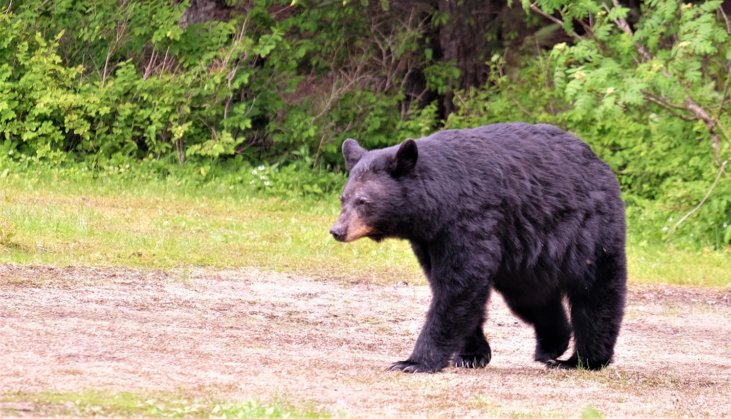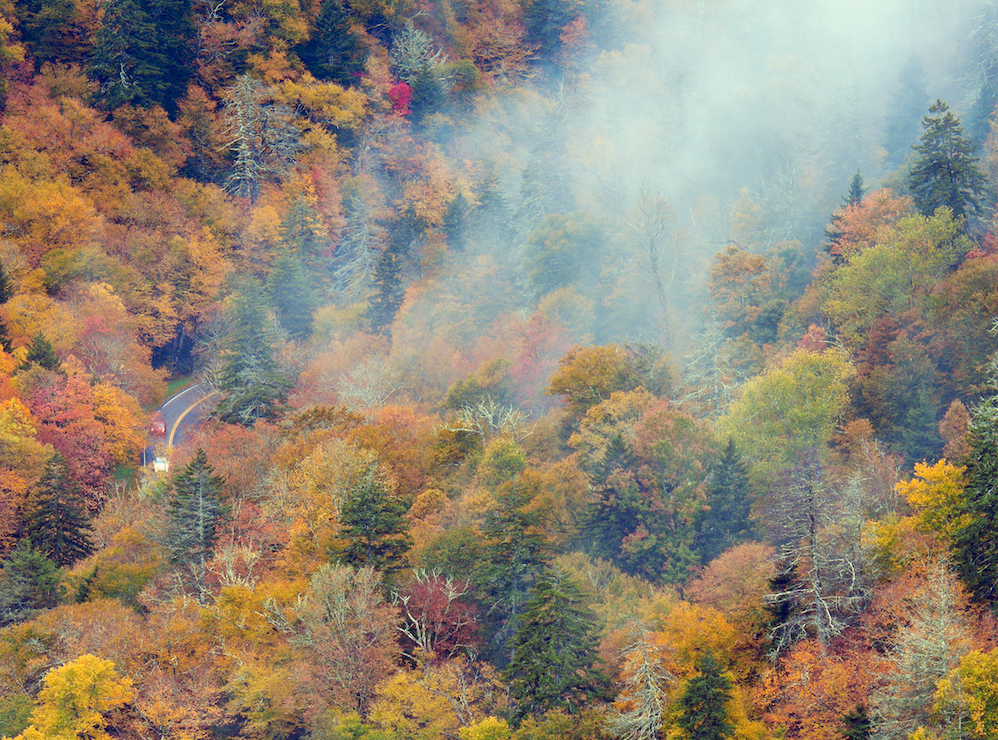There’s no more iconic wild resident of the Great Smoky Mountains than the black bear, which could justifiably be called the animal symbol of the range. This is the creature that the average visitor to Great Smoky Mountains National Park is most excited to see—and the one that inspires the most fear, which is mostly unwarranted. (We’ll get into that.)
Let’s take a closer look at this awesome and intelligent beast, and talk about where and when you’ve got the best chances of spotting it on your next visit to the park!
Introducing the Black Bear

The American black bear is the most numerous of the world’s bears, and in the size department falls third on the list after the significantly heftier polar bear and brown bear. Black bears once ranged over most of North America south of the tundra and down to northern Mexico. Although their range has been reduced in the wake of Euro-American settlement, they’ve managed to reclaim a lot of former territory in the past few decades. The black bear is the only bear native to the eastern U.S.; the grizzly, a subspecies of brown bear, was historically found from about the Great Plains westward, and in the Lower 48 today mainly is restricted to the Rocky Mountains.
Despite its name, the American black bear can come in a variety of fur colors, including cinnamon and chocolate-brown. In the Great Smokies and elsewhere in the East, though, most black bears are actually black. Sometimes you’ll see a bear with a white patch or collar on its chest, a marking that’s more common in the Asiatic black bear (a slightly smaller and slightly shagger Old World cousin).
Female black bears, called “sows,” tend to weigh between about 100 and 250 pounds. Males, or “boars,” typically tip the scales between about 200 and 600 pounds. In the fall, when black bears have been packing on the pounds ahead of their winter sleep, exceptional boars may weigh 800 pounds or more!
Black Bears in the Great Smoky Mountains
The Great Smokies are one of the world’s great bear sanctuaries, bar none. The size and variety of the Smoky Mountain wilderness, the fertility of its forests, and the protection offered by its national park status all translate to black-bear heaven. Great Smoky Mountains National Park supports on the order of 1,600 black bears at a density of about two per square mile: pretty impressive! Bears here have rebounded from past hunting and habitat loss, but the species never disappeared from the Smokies in historical times: This has been prime bear country for a long time.
Like black bears throughout their range, Smoky Mountain bears are omnivores: that is, they eat both plant and animal matter. Plants, though, are definitely the mainstay, especially fruits, berries, and nuts (“mast”) but also grasses, sedges, leaves, stems, buds, and tree bark. Insects and other invertebrates such as ants, beetles, and grubs are hugely important in the black bear’s diet as well.
Contrary to common perception, the red-meat side of the menu is pretty small. Back bears will happily eat carrion (dead animals), and will occasionally catch deer fawns and small mammals when the opportunity presents itself. Mushrooms, fish, and (unfortunately) human food scraps and garbage are other miscellaneous eats.
Bears in the Great Smokies have a wide-ranging seasonal routine set mostly by when and where food is most abundant and nutritious. They spend the winter in a hibernation-like state of rest—not because it’s too cold for them, but because of limited forage. When they emerge in spring, they do their best to regain the weight lost over the winter by seeking out greenery and whatever else they can find. Vegetation and insects become more available as spring unfolds in the mountains.
By summer, berries and wild grapes draw bears, and the peak fall smorgasbord adds the “hard mast” of acorns and hickory nuts. Fall’s when bears ramp up their food intake, intent on building up fat reserves for their extended winter siesta.
Winter dens may be cavities under tree roots, rotten stumps, or—as is often the case in the Great Smokies—up in holes or hollowed-out trunks of large trees. The abundance in the Great Smoky Mountains of massive trees and standing snags—old-growth features that are rare these days across most of the East—gives black bears plenty of off-the-ground denning options.
Black bears in the Smokies usually mate in July or so, and cubs—generally two to four—are born in late winter inside the sow’s den. Cubs stay with their mother until they’re about a year-and-a-half old (or whenever she decides to mate again), in the meantime learning the best foods to eat and where and when to find them.
Staying Safe Around Black Bears
Despite their reputation, black bears are by nature not aggressive toward people. In most parts of their range, black bears typically run the other way when they see us. Bears in the “front-country” of Great Smoky Mountains National Park near roads and campgrounds may be accustomed enough to humans that they don’t run away so readily, but in almost all cases they’re interested only in going about their own business. The main problem is when people approach bears to give them a handout or get a close-up picture—both against park rules—or when bears have become accustomed to scavenging garbage.
If you see a black bear on the trail or in a campground, don’t approach it. Allow it to move through the area, keeping a safe distance. In the rare case a bear comes toward you or follows you, hold your ground, talk or shout loudly at it, and if necessary throw rocks or sticks at it. A bear attack in the Great Smokies is extremely unlikely, but if it happens fight back aggressively—don’t play dead.
Where to Spot Black Bears
You can potentially see a black bear anywhere in Great Smoky Mountains National Park: dashing across the Roaring Fork Motor Nature Trail, wandering through a high-mountain bald, or anywhere in between.
But your all-around best chance of glimpsing a bear in the park is in Cades Cove, especially in early morning and evening hours. Bears often graze and browse in this broad basin, so keep your eyes peeled. Binoculars are a great help in scanning for bears and observing them more satisfyingly at a responsible distance.
It goes without saying you have the best opportunity to see black bears in the park between early spring and late fall. That said, bears sometimes emerge from their winter dens and wander about.
Seeing a black bear in the Great Smokies is exciting and inspiring: a glimpse of the wild nature of the mountains. Here’s wishing you a safe and rewarding bear sighting or two when you next come to this incredible place!




